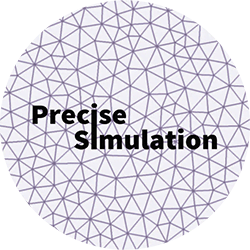
|
FEATool Multiphysics
v1.17.5
Finite Element Analysis Toolbox
|

|
FEATool Multiphysics
v1.17.5
Finite Element Analysis Toolbox
|
EX_NAVIERSTOKES15 2D Channel flow driven by periodic pressure difference.
[ FEA, OUT ] = EX_NAVIERSTOKES15( VARARGIN ) Sets up and solves stationary Poiseuille flow in a rectangular channel driven by a periodic pressure difference. The flow profile is constant and should assume a parabolic profile u(y)=dp/dx/2/miu*y*(h-y). Accepts the following property/value pairs.
Input Value/{Default} Description
-----------------------------------------------------------------------------------
rho scalar {0.1} Density
miu scalar {0.2} Molecular/dynamic viscosity
dp scalar {0.3} Pressure difference between in and out-flow
h scalar {0.5} Channel height
l scalar {2.5} Channel length
igrid scalar 1/{0} Cell type (0=quadrilaterals, 1=triangles)
hmax scalar {0.04} Max grid cell size
sf_u string {sflag2} Shape function for velocity
sf_p string {sflag1} Shape function for pressure
iphys scalar 0/{1} Use physics mode to define problem (=1)
iplot scalar 0/{1} Plot solution and error (=1)
.
Output Value/(Size) Description
-----------------------------------------------------------------------------------
fea struct Problem definition struct
out struct Output struct
cOptDef = { 'rho', 0.1;
'miu', 0.2;
'dp', 0.3;
'h', 0.5;
'l', 2.5;
'igrid', 1;
'hmax', 0.5/10;
'sf_u', 'sflag2';
'sf_p', 'sflag1';
'iphys', 1;
'iplot', 1;
'fid', 1 };
[got,opt] = parseopt(cOptDef,varargin{:});
fid = opt.fid;
% Model parameters.
rho = opt.rho; % Density.
miu = opt.miu; % Molecular/dynamic viscosity.
global dp
dp = opt.dp; % Pressure differetial.
% Geometry and grid parameters.
h = opt.h; % Height of rectangular domain.
l = opt.l; % Length of rectangular domain.
% Discretization parameters.
sf_u = opt.sf_u; % FEM shape function type for velocity.
sf_p = opt.sf_p; % FEM shape function type for pressure.
% Geometry definition.
gobj = gobj_rectangle( 0, l, 0, h );
fea.geom.objects = { gobj };
fea.sdim = { 'x' 'y' }; % Coordinate names.
% Grid generation.
fea.grid = rectgrid(round(l/opt.hmax),round(h/opt.hmax),[0 l;0 h]);
if( opt.igrid~=0 )
fea.grid = quad2tri( fea.grid );
end
% Boundary conditions.
dtol = opt.hmax/2;
i_inflow = findbdr( fea, ['x<',num2str(dtol)] ); % Inflow boundary number.
i_outflow = findbdr( fea, ['x>',num2str(l-dtol)] ); % Outflow boundary number.
% Problem definition.
fea = addphys(fea,@navierstokes); % Add Navier-Stokes equations physics mode.
fea.phys.ns.eqn.coef{1,end} = { rho };
fea.phys.ns.eqn.coef{2,end} = { miu };
fea.phys.ns.sfun = { sf_u sf_u sf_p }; % Set shape functions.
fea.phys.ns.bdr.sel([i_inflow i_outflow]) = 4;
fea = parsephys(fea); % Check and parse physics modes.
% Assign periodic BCs.
[fea.bdr.d{3}{[i_inflow i_outflow]}] = deal( [] );
[fea.bdr.n{3}{[i_inflow i_outflow]}] = deal( @periodic_pressure_bc_2_4 );
% Check and parse problem struct.
fea = parseprob( fea );
% Call to stationary solver.
fea.sol.u = solvestat( fea, 'fid', fid, ...
'nlinasm', [1 1 1], 'tolchg', 1e-2, 'toldef', 1e-4 );
% Postprocessing.
s_velm = 'sqrt(u^2+v^2)';
s_refsol = [num2str(dp),'/',num2str(l),'/2/',num2str(miu),'*y*(',num2str(h),'-y)']; % Definition of velocity profile.
p = [ l/2*ones(1,25); linspace(0,h,25) ];
u = evalexpr( s_velm, p, fea );
u_ref = evalexpr( s_refsol, p, fea );
if ( opt.iplot>0 )
figure
subplot(3,1,1)
postplot(fea,'surfexpr',s_velm,'evaltype','exact')
title('Velocity field')
subplot(3,1,2)
postplot(fea,'surfexpr','p','evaltype','exact')
title('Pressure')
subplot(3,1,3)
plot( u, p(2,:) )
hold on
plot( u_ref, p(2,:), 'k.' )
legend( 'Computed solution', 'Reference solution','Location','West')
title( 'Velocity profile at x=l/2' )
ylabel( 'y' )
end
% Error checking.
err = sqrt(sum((u-u_ref).^2)/sum(u_ref.^2));
if( ~isempty(fid) )
fprintf(fid,'\nL2 Error: %f\n',err)
fprintf(fid,'\n\n')
end
out.err = err;
out.pass = err<0.05;
if ( nargout==0 )
clear fea out
end
%